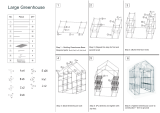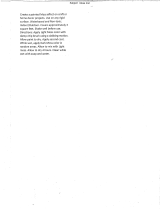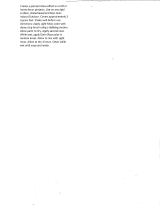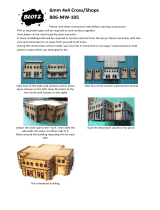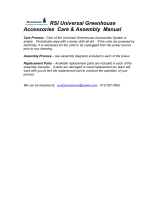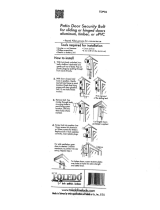Page is loading ...

11/14
S
t
a
n
d
a
r
d
b
u
i
l
d
i
n
g
E
x
t
e
n
s
i
o
n

2
8’ Wide Victorian Cedar Greenhouse
Extension Assembly Instructions
Contents:
Introduction
Base Preparation
Overview
Base Assembly
Side Assembly
Frame Assembly
Door Installation
Extension Assembly
A-frame Assembly
Roof Assembly
Mid Rail Assembly
Parts List
Section
-
1
2
3
4
5
6
7
8
9
10
Page
3
4
5-6
7
8-9
10-13
14-17
18-20
21-24
25-28
29
30

3
Introduction
Thank you for purchasing your new Alton greenhouse. We recommend you familiarise
yourself with the instructions and read all safety information before you commence assembly.
This instruction manual is also available online at www.greenhousepeople.co.uk in the
technical help section should you need to reprint it. Should you require any additional advice
you can always call us on 01782 385409.
Safety Warning
Glass, aluminium and timber can potentially cause injury. Please ensure you wear protective
goggles, gloves, headgear and suitable footwear when assembling and glazing the building.
Please remember that glass is fragile and should be handled with extreme care. Always clear
up and dispose of any breakages immediately.
Do not assemble the greenhouse in high winds.
For safety reasons and ease of assembly, we recommend that this greenhouse is assembled
by a minimum of two people.
Please clear all lying snow from the greenhouse roof as it can cause the roof to buckle or
collapse.
Site Preparation
When selecting a site for your greenhouse, it is vital that you choose as flat and level an area
as possible.
A concrete or slabbed base will provide the most solid foundation for your greenhouse. A
slabbed base would be our preferred choice as this helps with drainage.
Avoid placing your greenhouse under trees or in other vulnerable locations.
To minimise the risk of wind damage, try to select as sheltered a site as possible, e.g. beside a
hedgerow or garden fence.
Additional Considerations
Please bear in mind that assembling your greenhouse can be time consuming. You may need
to spread the construction over two or more days. We recommend that you avoid leaving the
building partially glazed. If you ever have to leave your greenhouse half assembled and not
anchored down, weigh it down with slabs or bags of sand to stop the wind moving it.
You will find it helpful to prepare a large, clean and clear area in which to work in. A garage
floor or flat lawn area is ideal.
If you have arranged for someone to install your greenhouse for you, please check that all
components are included. Most parts are numbered and can be identified by a stamp or
removable label. Alternatively, the components can be identified by lengths detailed in the
packing list in your main cardboard box.
Remember this is a natural timber product, the wood may soak up some water and some
staining may occur. Your Evolution greenhouse is factory dipped in a clear spirit based
preservative. We recommend that you re-apply some clear treatment annually particularly on
the most exposed areas. If you want to avoid this and give your greenhouse a more
permanent finish you could apply an oil based product (refer to manufacturers
recommendations for recoating).

4
Overview
1
25mm Pan Head
(Stainless Steel)
40mm Pan Head
(Stainless Steel)
50mm Countersunk (Stainless Steel)
80mm Countersunk (Stainless Steel)
Fixes all
capping and
Secures
Timber
Cladding
Fixes glazing
bars to ridge
and cills
Secures corner
joints and the
roof glazing
bars to the
ridge
19mm Pan Head
(Stainless Steel)
Fixes the
vent hinge
to the ridge
cover cap
25mm Countersunk
(Stainless Steel)
13mm Self Tapping
Used on
roof vents
EV0329
EV0328 EV0330 EV0331 EV0332 EV0333 EV0334
EV0339
Fixes the roof
glazing bars to
the eaves and
side glazing
bars in one go
100mm Countersunk (Stainless Steel)
This manual uses a 8 ft x 10 ft greenhouse as an
example throughout. Look out for tables and extra diagrams
showing the varying sizes. You can use the image on the front cover as
a reference as to what the greenhouse should look like as you go along.
If you are going to treat the greenhouse yourself then it would be best to do it
before you begin building the frame.
Set out your metal base on your prepared site, but don’t fix this down until the greenhouse
is complete. Follow the manual and build the sections as recommended.
When screwing through one piece of timber into another it is always recommended to predrill
the first piece. This will prevent the timber from splitting which could weaken the structure.
You can build the sides and gables flat on the ground and then with help or using a prop position the
first one ready for installation. You then work your way around the greenhouse connecting each
section. Once you have completed the gables and sides you can install the ridge and the roof.
To build your new greenhouse you will need the following tools:
Spirit Level Pencil
PZ2 Screwdriver Bit Cordless Screwdriver (2 would be ideal, 1 to drill and 1 to screw)
4mm Drill Bit 7mm Masonry Bit
Hammer Drill Hammer
Wooden/Rubber Mallet Tall step ladders x 2
There are 8 different types of screws used in the construction of the greenhouse. These are as
follows, with examples of where to look out for them:

5
Overview
2
Base Preparation
Glazing the structure is very simple but be very careful of the edges of the glass as the pane will
break into tiny peaces if you catch an edge on a hard surface such as concrete. You should also wear
suitable gloves and goggles when handling the glass (this also helps to keep it clean). It is good
practice to pre-load the cedar bar capping with screws and position this around the greenhouse
ready for you when you arrive with the glass.
During glazing you will also need to fit the louvre vents so make sure you have these built and ready
to slot in. These fit between 2 pieces of glass and are held in place by the capping system.
Then fit the roof vents. This is done from the inside, gain access through the opening on a set of
steps.
All you have left to do now is fit the gutter and downpipes, think about where you might site a water
butt when doing this.
Option of gluing joints. This is not required for strength but you may do it if you wish. However bare
in mind if you ever intend to move or adapt the greenhouse in the future this would make it very
difficult. The best glue for this would be Poly Urethane Wood Adhesive. Take care when applying
this, you only need a very small amount as the glue expands to fill the joint. If you use too much it
may seep out of the joint and could be unsightly! Try a test piece before you start.
Read through the rest of this manual before starting, you are less likely to miss something doing this
and you will have a better understanding of how it all works.
Refer to your individual base plan supplied with your order confirmation for dwarf wall dimensions.
It is necessary to leave sufficient working room around your greenhouse when you're putting it up
and also to allow for the possible need to replace a piece of glass in the future. If possible try and
leave a minimum space of 2ft/610mm around the greenhouse.
Note that the door opens inwards so you should not have any higher ground or obstacles inside the
front of the greenhouse.
Locate the greenhouse where there is maximum amount of sunlight and avoid if possible any shade
from trees, fences or other buildings. Over-hanging branches can be a particular nuisance and should
be avoided.
Choose a site where the greenhouse is relatively easy to get to and convenient to bring water to and
possibly a supply of electricity.
Finally, and most importantly, choose a site where your Alton Greenhouse will look right so that it
will complement your garden.

6
Side Assembly
Begin by laying out the components for your 2 extension sides flat on the ground as the diagram
below shows. Use the table below to help identify the components with the part numbers and sizes.
First of all drill pilot holes through the bottom of each mortise on the cill section (diagram 4, page 9).
Then slot each glazing bar into the mortise holes. These are designed as a tight fit so you may need
help with this or maybe use a solid object to push against. Once firmly in position fix with the 50mm
screw. Now slot the eaves rail into position. There is no need to fix this yet as it is done at a later
stage.
4
Part
Number
Size
(mm)
Qty
EV0176 2520 2
EV0423 2564 1
EV0501 1588 6
8ft Extension
Part Name
Cill
Eaves Bar L
Glazing Bar
Eaves Bar R EV0422 2564 1
R
i
g
h
t
h
a
n
d
e
a
v
e
s
b
a
r
e
xt
e
r
n
a
l
f
a
c
e
Diagram 1
E
V
0
4
2
2
EV0489
EV0422
EV0489
EV0489
Internal – Right hand
Dia. 1
EV0176
EV0176
EV0423
EV0489
Dia. 2
Dia. 3
Internal – Left hand side
EV0489
EV0489
Square cut
(no joint)
Dia. 4
Square cut
(no joint)

7
Side Assembly
4
Diagram 2
E
V
0
1
7
6
EV0489
E
V
0
1
7
6
EV0489
Make sure the side bars are pushed all the
way in, you may find they need a light tap
with a wooden mallet or something similar.
(If you are going to glue your joints this is the
first point you would do this. )
50mm Screw
Pilot hole, it is
easiest to drill
down through the
middle of the
mortise to make
sure you get the
hole in the correct
position
Internal
EV0489
E
V
0
4
2
0
Diagram 3
Internal
The side base plates should be fitted flush to the
ends of the side cills as shown in diagram 4. Fix
with 25mm screws.
Keep flush
at this point
E
V
0176
Diagram 4
E
V
0
6
4
8
M

8
5
Frame Assembly
Before you position your side section onto the dwarf wall you should drill the pilot holes in the
bottom of the side corner bars shown in diagram 6. The position of this hole should be about 19mm
from the side face and 30mm measured from the bottom of the bar.
You can now position the side section on the aluminium base, you will need a helper to hold this in
place or simply strap it to a set of steps.
Now offer the front gable to the side assembly slotting the
corner bar onto the end of the eaves bar, do not fix this
joint until the bottom joint is fixed (diagram 6). Screw the
bottom of the corner glazing bar to the end of the cill
(80mm screw) making sure the rebate for the glass lines up
with the front face of the side cill (diagram 5).
Dia. 6
Dia. 5

9
Frame Assembly
5
Diagram 6
Make sure the side corner bar is located
correctly and the front face is flush with the
end of the eaves bar, mark out the pilot hole
positions shown in diagram 7 and 8. Diagram
10 and 11 on the next page show the direction
the holes should be drilled in.
Diagram 7
Diagram 8
EV0503
E
V
0
4
83
E
V
0
4
1
5
EV0483
EV0503
38mm
28mm
22mm
41mm
Eaves bar
Eaves bar
Top View
External Side
External Front
Diagram 5
19mm
30mm
E
V
0
4
0
1
EV0491
80m
m
S
c
r
e
w
E
V
0
6
3
5
M
Keep faces
flush
External

10
5
Frame Assembly
Diagram 10
Diagram 11
Diagram 9
Before fixing this corner make sure the inside
faces are all flush (diagram 9). When you are
happy that the purling is located correctly (it is
normal that the purling is set back slightly
from the glass rebate on the front of the
building) start by inserting the 80mm screw
through the side of the eaves bar into the
tenon on the end of the purling.
Next insert the 100mm screw vertically down
through the roof corner bar into the eaves bar
and finally securing the side corner bar
(diagram 11).
Internal
8
0
m
m
S
c
r
e
w
E
V
0
4
8
3
E
V
0
4
1
5
EV0503
E
a
v
e
s
b
a
r
100mm Screw
100mm Screw
EV0415
E
V
0
4
8
3
EV0503
External
X-ray

11
Frame Assembly
5
Repeat the last few steps to install the right hand side of the frame. Keep
these sections supported in this state as the frame is quite fragile until it is
completed. Next you will partially fix the door in place to help brace the
two front gable sections together.

12
Diagram 31
Diagram 13
Your door will arrive already installed in the frame with
the lock and lock plate attached. All you need to do is
attach the door handle to install this to the building.
Start by sliding the spindle through the top hole in the
door (diagram 12), then locate one of the door handles on
this and fix with the screws provided. Repeat this on the
other side of the door (diagram 13).
Dia. 12
External Views
6
Door Installation
Diagram 12

13
Door Installation
6
Take the door to the greenhouse frame assembly
and slide it into place. Unlock and open the door
so that it is 90 degrees to the frame as shown in the
illustration on the opposite page.
You will need to pack the outside edge of the open
door, ideally with a wedge so you have some
adjustment or simply with some scrap cardboard
from the packaging. This will help you get the
frame in the correct position for fixing.
To start with you only need to put 4 fixings in the
frame, 1 on either side at the top and the same at
the bottom. The 50mm screws should go through
the same face that the strike plate is mounted on
and where the hinges are mounted on the other
side. The back of the frame should line up with the
inside face of the gable glazing bar, this should
then also mean that the glass rebate on the frame
header will line up with the rebate on the gable
glazing bars (diagram 15).
When you are happy with the position of the frame
fix it with the 50mm screws as shown on the
opposite page. This is only an initial fix and
adjustments can be made later.
Diagram 14
Diagram 15
Fix through
this face
Keep faces flush
E
V
0
5
3
0
EV0532
EV0507
E
V
0
5
3
2
EV0608
Door Parts
Part Name Part
Number
Qty
Door Lock EV0606 1
4” Hinges EV0607 3
Door Handle Set EV0608 1
Single Door EV0710 1
EV0710
External
External
Note: door opens
inwards
E
a
v
e
s
b
a
r

14
6
Door Installation
Once the frame is
secure drill a pilot
hole through the
mortise slot in the
door frame header
(diagram 19).
A
B
B
A
Diagram 16
Diagram 19
E
V
0
5
3
0
You should use four
50mm screws at the
points shown as ‘A’ below.
You don’t want to fix to
the brickwork until you
are absolutely happy with
the position and trueness
of the greenhouse frame.
Only when the
greenhouse has been
glazed and you are ready
to fix the building to the
brickwork should you fix
the door frame at the
points shown as ‘B’ below.
Make sure the door frame
posts are vertical and are
the same width apart all
the way down (pack the
frame out if necessary).
Also its better to avoid
drilling into the top
course of bricks as this
could dislodge them.
Dia. 18
Dia. 17

15
Door Installation
6
Slot the above door
glazing bar into the
mortise slot in the
door frame header and
secure it with a 50mm
screw.
50mm Screw
EV0472
E
V
0
5
3
0
Diagram 20
Dia. 20
External

16
Extension Assembly
7
Dia. 21
Dia. 22
Slide the left hand side
extension up to the first side
section. Locate the tenon on
the end of the eaves extension
bar with the mortise slot on the
standard eaves bar.
Diagram 21
Internal
S
t
a
n
d
a
r
d
E
a
v
e
s
B
a
r
E
V
0
4
2
3
Using eight 25mm
screws secure the
two cills to the
aluminium base.
Leave out the two
screws at the
mortise joint until
you have installed
the side extension
glazing bar.
Diagram 22
E
V
0
1
7
6
Internal
2
5
m
m
S
c
re
w
S
ta
nd
a
r
d
C
i
l
l
E
V
0
6
5
1
M
S
t
a
n
d
a
r
d
B
a
s
e
EV
0
2
9
9
M

17
Extension Assembly
7
Dia. 24
Dia. 23
5
0
m
m
S
c
r
e
w
EV0500
EV0500
EV0500
EV
0
4
2
3
S
t
a
n
d
a
r
d
E
a
v
e
s
B
a
r
E
V
0
1
7
6
2
5
m
m
S
c
r
e
w
S
t
a
nd
a
r
d
C
i
l
l
Diagram 23
Diagram 24
Next fit the side extension bar, first slot the
tenon on the end of the bar into the mortise
in the cill. Slot the top into position, lining
the edge of the bar up with the joint of the
two eaves bars. Secure this with a two
50mm screw and the secure the bottom
with two 25mm screw., remember to drill a
pilot hole first.
Diagram 25
Internal
Internal

18
7
Extension Assembly
Now install the rear of your greenhouse, refer
to page 9 and 10 for the fixing of this.
Repeat the last two steps to fix the other extension side to the building.

19
A-frame Assembly
8
You can start building the A-frame next. Take the
eaves extension braces and locate them in the
mortise slots in the extension side bars. Pilot hole
and fix these with 40mm screws. Make sure the flat
face that meets the side bar is seated correctly
before fixing.
Dia. 26
4
0
m
m
S
c
r
e
w
EV0500
EV0500
E
V
0
7
2
4
Diagram 26
Diagram 27
Internal

20
8
A-frame Assembly
Dia. 28
Diagram 28
Now slot the extension roof bars into
place, these are easy to identify as
they have mortise slots cut into them.
Don’t fix them at this point as you will
need some flexibility for when you
install the A-frame brace.
E
V
0
7
2
4
E
V
0
4
8
7
Internal
/

